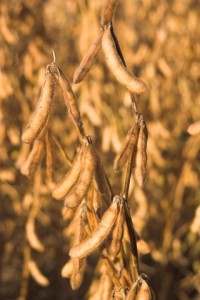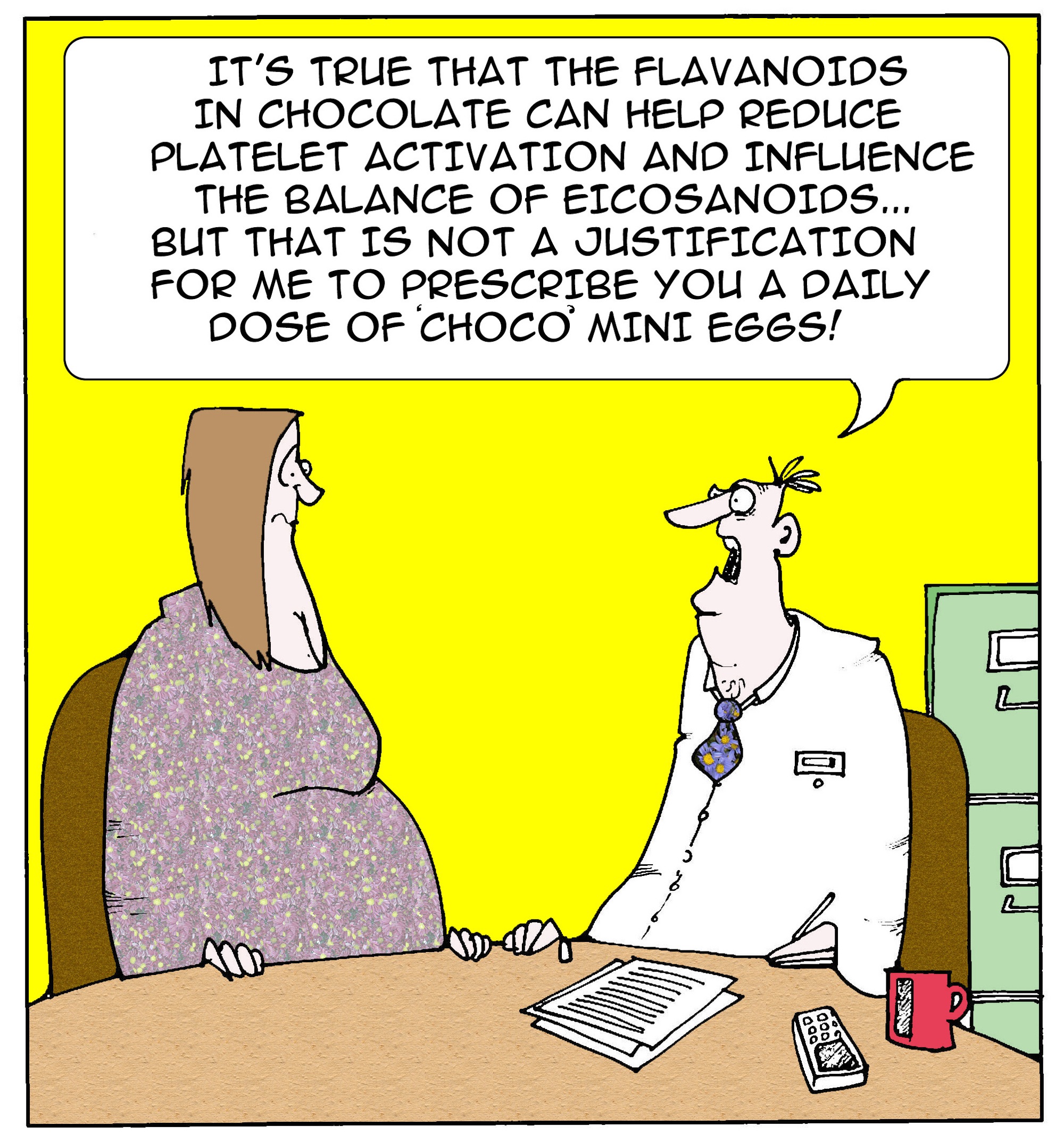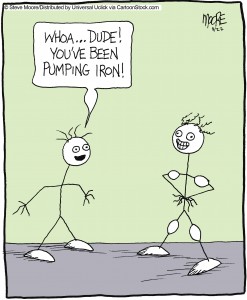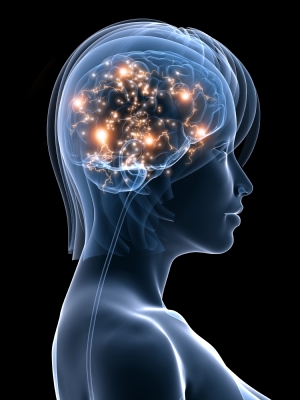Iso what? Iso who? Hot flashes, isoflavones and clinical trials
 I’ve long been intrigued by the replacement of hormone replacement therapy with soy isoflavones. Yet, studies looking at their effectiveness for alleviating hot flashes and other vasomotor symptoms have been mixed. The reasons for this are multiple, and point to such factors as dose and actual composition of the supplements used, severity of hot flashes and how often women are taking isoflavones over the course of the day. Researchers have also discovered that only 20% to 30% of Westerners produce equol, (there’s even a dispute over this stat) a component of the potent isoflavone dadzein that has an affinity for estrogen and appears to be slowly cleared from the body;(note that both of these factors contribute to its beneficial effect against flashes.
I’ve long been intrigued by the replacement of hormone replacement therapy with soy isoflavones. Yet, studies looking at their effectiveness for alleviating hot flashes and other vasomotor symptoms have been mixed. The reasons for this are multiple, and point to such factors as dose and actual composition of the supplements used, severity of hot flashes and how often women are taking isoflavones over the course of the day. Researchers have also discovered that only 20% to 30% of Westerners produce equol, (there’s even a dispute over this stat) a component of the potent isoflavone dadzein that has an affinity for estrogen and appears to be slowly cleared from the body;(note that both of these factors contribute to its beneficial effect against flashes.
Despite these challenges, what would happen is you simply upped the dose and/or frequency? Would it change the’ iso what’ or ‘who’ to an actual ‘iso yes!?’
That’s exactly what researchers sought to learn when they recruited 130 peri- and post-menopausal women with severe hot flashes (i.e. five or more a day). Women who produced equol and those who did not were separated and then randomly asked to take placebo, low dose (33 to 66 mg/day) or high dose (110-200 mg/day) equol or placebo capsule (s) and take them once daily or two to three times daily. They also kept daily hot flash diaries, assessing each hot flash by its intensity, daytime or nighttime occurrence and how bothersome they were. They met with the research team face to face twice — 9 weeks in, and 3 weeks after the study completed.
The findings made it quite clear that dose and frequency are almost as important as whether or not a person is able to produce equol. In fact, when women took higher doses of isoflavones more frequently, they had 2.4 per day fewer hot flashes than women taking the lower doses just once a day. And, the flashes were significantly less severe. What’s more, most of these benefits were realized during the night, when, as most of us know, flashes and sweats are especially disruptive. Moreover, there was not much of a difference between women who are able to produce equol and those who are not; while these women did experience greater declines (as much as 10%) in both how intense their flashes were and how frequently they occurred, the difference was apparently not statistically significant.
So, let’s cut through the scientific clutter:
- Higher doses of isoflavones tend to have a greater effect than lower doses
- More frequent dosing (two to three times a day) appears to be more beneficial than once a day dosing.
- Greater benefits are likely to be seen in women who naturally produce equol, especially when it comes to hot flash intensity
- Both perimenopausal and menopausal women may potentially benefit from higher, more frequent dosing.
This type of research is just beginning and the findings need to be teased out in larger numbers of women. It’s also unclear if spreading the lower dose out throughout the day would make a difference. Still, what these findings do bring to light is an evolution of thinking and that’s what makes me most excited. Rather than determining that isoflavones are useless, researchers are finally starting to treat them as though they were pharmaceutical agents, using them in randomized clinical trials, varying doses, frequency and patient populations and truly, thinking outside the box.
Read More
You don’t need ripped; you just need to get it right
There are some days when growing older simply feels like a big old pain in the butt. Despite the wrinkles, grey hairs and even sags in places we didn’t know could sag, there are important steps you can take to keep some parts of the aging process at bay, such as a loss of muscle. And while many of us stay strapping until about the age of 40, after that time there is evidently a progressive decline in muscle, leading to eventual weakness, slowing of movement and even disability. Have you ever observed an elderly person trying to rise from a chair or climb the stairs? It’s tough to watch, right?
Fortunately, researchers say that there are a few steps that you can take to slow the process and protect what you have, even if you are past the age of 40. Mind you, the rate at which muscles age can vary widely between individuals and genetics do play a role. In fact, genetics may be responsible for more than half of muscle variance and this variance is evidently is driven by your mother’s genes; not only is her longevity predictive of how long you might live but it also affects muscle size and strength as you grow older.
Not surprisingly, hormones also play a role. Darn, that estrogen keeps rearing her ugly head! Indeed, it appears that not only do declines in estrogen impact skeletal muscle structure but also function, robbing women of the much needed ability to keep muscles tense when they need to be.
Still, researchers say that there are still opportunities to modify the trend.
- Nutrition is important. You’ve heard the caloric restriction can prolong life, right? But it’s not without risk and researchers say that lower food intake can lead to reduced nutrient intake, which actually boosts systemic inflammation, a culprit in muscle loss as well as a host of other illnesses. But supplementing with antioxidants, incorporating omega-3s into the diet and focusing on amino acid, leucine rich foods, such as cottage cheese, egg whites, low-fat beef, fish, chicken, lentils and soybeans (all of which provide ample protein) may hep to reduce inflammation, improve muscle function (namely the functioning of muscle fibers) and boost muscle size.
- Physical activity is key! Exercise actually reduces low-grade systemic inflammation that plagues our bodies as we age. And, it directly benefits skeletal muscle by helping to maintain the function of muscle fibers, attenuate the loss of muscle units and help reduce the loss of cells that are important for muscle regeneration. Regular exercise may also help the body to oxygenate muscles and tissues, another factor that declines with aging.
Listen up! Keeping muscles strong and healthy doesn’t mean that you need ripped. However, what it does mean is that you need to get it right. Exercise your brain on this one, make sure that you are getting proper nutrition and move your body. And start now; not when you are sitting in that chair struggling to get up.
Read More
Wednesday Bubble: Eating your way through the ‘pause
I’ve written a lot about diet and maintaining a healthy weight , as well as impact on overall health as you age. And I will continue to do so as long as Flashfree is published. However, I have not written much on diet and how it affects symptoms, mostly because the evidence is pretty scant in that regard. Still, it has come up in conversations repeatedly and I feel that it’s time to at least broach the topic, especially since I discovered Dr. Akiko Sugahara, a Tokyo-based nutrition, anti-aging and women’s health specialist and her book, Menopause Recipes for Health and Beauty.
When it comes to maintaining health, obtaining minerals and vitamins through dietary sources is always preferable although not always possible. And while I cannot vouch for anything that Dr. Sugahara has shared in her book, her publicist did reach out with an offer to let me share a few pages here. Draw your own conclusions; we do know that not all soy products are created equal, and that isoflavone benefits may vary as well. Still, Dr. Sughara’s message is health comes first, which is why I chose this particular section to reprint in part. Please note that in her ebook, Dr. Sughara actually provides 10 ideas, which I have condensed for space purposes. If you want to read more, do download her book on her Facebook page.
Thank you Dr. Sughara, for providing your words to this post.
A deterioration in your physical condition during menopause renders you more vulnerable mentally. In this section, we present concrete ideas that will help you to manage menopause skillfully and improve your physical and mental health.
Taking a closer look at your everyday diet and identifying the problems.
Food preparation at home can sometimes fall below standard once the children have grown up. Before you know it, you might find yourself snacking instead of eating proper meals, eating lots of precooked meals and instant foods from your local supermarket or eating out more than you should. Where your diet is concerned, it is well worth making that extra effort for the sake of your own health and that of your family.
To identify potential problem areas, let’s first itemize your food balance.
Fermented soybean products more effective than supplements
The effectiveness of isoflavone in alleviating menopausal disorders is often discussed on television, and the link between soybeans and isoflavone is now common knowledge. Daily consumption of raw tofu, dried tofu, fermented soybeans, boiled beans or other soybean products is essential in treating and preventing menopausal disorders. Soybean milk, for example, is a convenient source of such also chill your body somewhat, so it is best consumed as an ingredient in stews and other hot dishes. Fermented foods, such as miso and vinegar, are more readily absorbed by the body and therefore provide isoflavone with a stronger effect.
Constipation relief as the basis for menopause relief
Many women with severe menopausal symptoms suffer from constipation. This condition also renders its sufferers more sensitive to the cold, often contaminating the blood and preventing it from flowing smoothly. This in turn reduces the amount of oxygen reaching the brain, making you absentminded and unable to organize your thoughts to get things done. Curing constipation therefore restores the blood flow to your extremities, bringing back the warmth to your hands and feet. The most effective cure for constipation is a diet of foods rich in isoflavone and polyphenols and especially dietary fibre, and sprouted brown rice is a prime example of these. Be wary of long-term use of medicinal laxatives, since they cause body chills that are felt deep inside your body.
Combating obesity with foods in 5 colours
Menopause is often accompanied by weight gain. Overeating to console loneliness is a primary cause, and a healthy digestive system will readily convert any excess intake into fat. This often results in a shortage of essential B- group vitamins, which promote complete combustion of nutrients and improve rain function, making it difficult to burn stored body fat. To combat weight gain, you should reduce your consumption of sweets and fruit and increase your consumption of stews made from as many as possible of the ingredients in the five basic colours. If you are susceptible to weight gain, then a staple of sprouted brown rice and wholegrain bread and an appropriate amount of exercise are recommended. This alone should eliminate obesity, helping menopausal symptoms to disappear naturally.
Dried foods effective for chills and abdominal ptosis
Many women who suffer from chills also have abdominal ptosis, or drooping of the viscera. This condition causes a deterioration in the secretion of gastric acid, preventing the essential absorption of iron and copper. It also causes the stomach to become bloated, so fatty foods lose their taste, and at the same time it restricts the consumption of plain foods. Consequently, some women skip breakfast or lunch or eat too little generally, resulting in a diet deficient in protein, iron and vitamins. To make things worse, the greater sensitivity to the cold that accompanies this condition can cause insomnia. The solution is to eat lots of shellfish, prunes and other dried fruits, cooked foods with iron and copper-rich whole-fish dishes and fried liver and vegetables. To compensate for the reduced amount of stomach acid, perhaps it would be a good idea to also eat foods containing vinegar and hot Chinese-style dishes with flavoured vinegar or to use pickled Japanese apricots in your cooking.
Idea 5: Combating osteoporosis with dried foods and fermented foods
Female hormones strengthen the bones to mitigate the effects of bone aging. As the secretion of female hormones declines, more bone cells are destroyed than are produced, and osteoporosis soon sets in, leaving the bones thinner and more porous and brittle. One way of dealing with osteoporosis is to include calcium-rich small fish, dried foods and fermented foods in your diet and to walk between 30 minutes and one hour every day. Another is to compensate for the decline in female hormones by eating plenty of isoflavone-rich foods such as miso soup and fermented soybeans to prevent body chills. Whenever possible, it is preferable to cure yourself using your own efforts rather than relying on yourdoctor.
Read More
Wednesday Bubble: This is your brain. This is your brain on phytoestrogens.
Do phytoestrogens improve cognitive performance?
This is the first I’ve heard that phytoestrogens, i.e. isoflavones, lignans (a major form of phytoestrogens found in flaxseed and sesame seeds) and coumestans (a type of phytoestrogen found in split peas, pinto beans and lima beans) may help boost attention, executive function and memory. Yet, similar to other alternative strategies, the studies examining these benefits have yielded mixed results. Moreover, a lot of these studies have been based on short-term and not long-term use of phytoestrogens, have failed to determine how these compounds may influence brain function, and have not looked specifically at women undergoing the menopausal transition, at least until now.
This time, researchers took a cohort of women actively involved in the Study of Women’s Health Across the Nation. All 1,677 women who saw the study through to its end were between the ages of 42 and 52, premenopausal, early or late perimenopausal, and naturally or surgically postmenopausal, and were not using hormones. Importantly, this group of women included several ethnic groups, which allowed the researchers to see if phytoestrogens behaved differently depending on ethnicity; they included white, African American, Hispanic, Chinese and Japanese.
- Diet was regularly evaluated and included interviews, open ended questions and specifically, daily intake of four types of isoflavones, four types of lignans and coumesterol, which is the main phytoestrogen in coumestans. In Asian women, soybeans, tofus and soy milk were the main sources of isoflavones while in non-Asian women, soy mik, tofu and meat substitutes (e.g. seitan) were the main sources. Regardless of ethnic group, coffee and tea were the primary sources of lignans, and bean sprouts, the main source of coumestans.
- Cognitive testing was done in the morning and always in the same language for bilingual women. These tests included processing speed, immediate and delayed recall and working memory.
- The study took place over 6 years and women were visited 10 times.
So, what did they learn?
First, phytoestrogens appear to affect cognitive function differently, depending on the type and stage of menopause. For example, Asian women whose diets had high levels of isoflavones tended to process information quicker but only during early perimenopause and postmenopause. Conversely, during the same time, these women had poor recall. Non-Asian women who ate a lot of isoflavones also had poor recall during perimenopause. Moreover, women who ate the most lignans, regardless of ethic group, appeared to have better memories but only during late perimenopause. Overall, coumestans did not appear to influence brain function whatsoever.
It’s all sort of confusing, isn’t it? What’s more, even the researchers admit that the effects, when seen, were quite small. And the distinctions between Asian and non-Asian women? It’s the chicken/egg paradigm: is it dose or DNA? At the end of the day, it’s all bubble burstable because scientists remain unclear as to how phytoestrogens affect the way we process information. It is possible that its due to their antioxidant characteristics, but who knows?
Meanwhile? Despite potential GI tract issues (e.g. gas, bloating, constipation), incorporating higher levels of phytoestrogens into your diet may be a good thing. Your brain on phytoestrogens? Who doesn’t need a little boost?
Read MoreLoco for cocoa – chocolate and your heart
 Last June and August, I wrote about the link between eating chocolate and improving heart health. Briefly, researchers have long been interested in flavonoids and in particular (at least in so far as menopause goes) in isoflavones. (See soy posts for more on isoflavones). The specific compound or molecule of interest in cocoa (the non-fat component cocoa bean extract or liquor) are flavanols, which are also found in lower concentration in apricots, peaches, apples, green and black tea, red wine and cider). Note that the quantity of flavanols in chocolate depends on manufacturing, including fermentation and roasting, and how much treatment is given to reducing bitterness and improving consistency. What this means is that dark chocolate has the highest concentration of flavanols and milk, the lowest.
Last June and August, I wrote about the link between eating chocolate and improving heart health. Briefly, researchers have long been interested in flavonoids and in particular (at least in so far as menopause goes) in isoflavones. (See soy posts for more on isoflavones). The specific compound or molecule of interest in cocoa (the non-fat component cocoa bean extract or liquor) are flavanols, which are also found in lower concentration in apricots, peaches, apples, green and black tea, red wine and cider). Note that the quantity of flavanols in chocolate depends on manufacturing, including fermentation and roasting, and how much treatment is given to reducing bitterness and improving consistency. What this means is that dark chocolate has the highest concentration of flavanols and milk, the lowest.
What have researchers learned so far?
- Flavanols found in cocoa and cocoa powder may be powerful antioxidants and as such, help to mitigate certain factors that contribute to atherosclerosis, such as the formation of plaques in the arteries that lead to stroke and other coronary events. Thus, as antioxidants, they may actually neutralize toxic oxygen species circulating in the bloodstream.
- Experimental data suggest that ingestion of flavanols may help to regulate proteins and other compounds that encourage an inflammatory response to leads to heart disease.
- Flavanols may also help to stabilize the lining and muscular tone of the arteries and prevent them from narrowing.
- Additionally, flavanols may moderately protect against high blood pressures, although studies have been mixed.
- Finally, flavanols may help to maintain blood sugar levels and improve the ratio of good to bad fats in the blood.
However, while numerous studies suggest that chocolate may benefit the heart, less clear is whether or not a causal relationship exists. Still, the idea is attractive enough that researchers continue to delve into the potential benefits of functional foods containing flavonoids and in flavonols found in dark chocolate. This time, writing in the journal Appetite, they report on a newly published study that examined the effect of eating flavonoid-rich dark chocolate on a process called oxidative stress, in which the ratio of circulating oxygen free radicals to circulating antioxidants is imbalanced (free radicals are those nasty, unstable molecules or atoms that can wreak havoc and lead to disease, including heart disease, diabetes and high cholesterol).
Over a period of three weeks, 25 healthy men and women were asked to eat 50 g of dark chocolate daily. The women in this particular study were premenopausal, primarily because use of hormone replacement has been shown to modify oxidative stress that has been attributed specifically to LDL (low density lipoprotein, also known as the bad cholesterol). They also omitted any other cocoa products from their diet and tea, red wine and other drinks that were rich in antioxidants.
Not only did eating dark chocolate daily have no impact on body mass index or the subjects’ weight, but it significantly increased the percentage of HDL (high density lipoprotein or good cholesterol) and led to a significant declines in blood fats levels as well. Dark chocolate consumption also appeared to lower markers of oxidative stress and damage to good fats in cells by almost 27% in women in the study, indicating a favorable effect on LDL, a change that was not similarly observed in men. This suggests that eating dark chocolate could possibly benefit women more than men, at least in terms of the heart. And, while menopausal women were not studied, the researchers say that the protective role of dark chocolate could possibly be especially favorable during menopause, when waning levels of estrogen make women particularly sensitive to oxidative damage and heart disease.
As with similar studies, we still don’t have a definitive cause and effect. However, a little dark chocolate has the potential to go a very long way.
Read More









